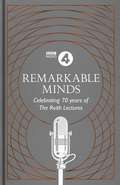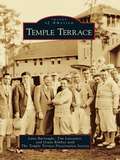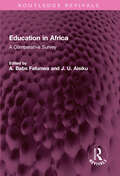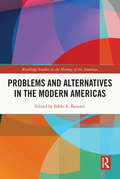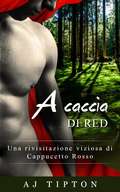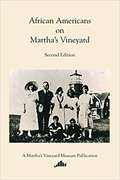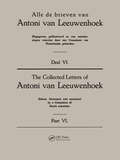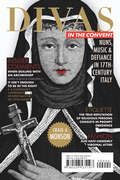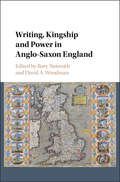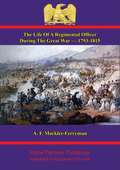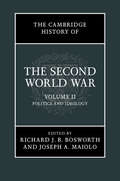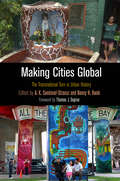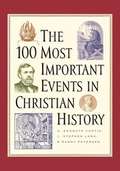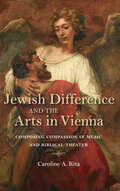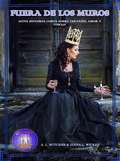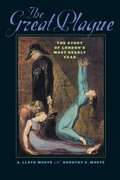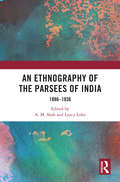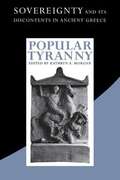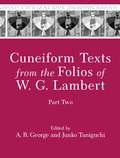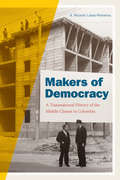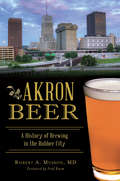- Table View
- List View
Remarkable Minds: A Celebration of the Reith Lectures
by BBC Radio 4IDEAS THAT HAVE THE POWER TO CHANGE THE WORLDThe best of an extraordinary 70 year archive, gathered in one volume for the first time. The prestigious BBC Reith Lectures have been enriching the world with new ideas since 1948. Every year, a world-leading thinker is invited to speak on a topic of their choosing, spanning art, science, nature, technology, history, religion, society, culture, politics and much more. Unearthing forgotten gems as well as sharing the latest in intellectual thought, Remarkable Minds is a time capsule into our changing world that provides wise words for turbulent times. With a foreword by Anita Anand, presenter of the Reith Lectures, and an introduction by Gwyneth Williams, controller of Radio 4, 2010-2019.
Remarkable Minds: A Celebration of the Reith Lectures
by BBC Radio 4IDEAS THAT HAVE THE POWER TO CHANGE THE WORLDThe best of an extraordinary 70 year archive, gathered in one volume for the first time. The prestigious BBC Reith Lectures have been enriching the world with new ideas since 1948. Every year, a world-leading thinker is invited to speak on a topic of their choosing, spanning art, science, nature, technology, history, religion, society, culture, politics and much more. Unearthing forgotten gems as well as sharing the latest in intellectual thought, Remarkable Minds is a time capsule into our changing world that provides wise words for turbulent times. With a foreword by Anita Anand, presenter of the Reith Lectures, and an introduction by Gwyneth Williams, controller of Radio 4, 2010-2019.
Temple Terrace (Images of America)
by 999 Lana Burroughs Grant Rimbey Tim LancasterThe influential and adventurous Chicago socialite Mrs. Potter Palmer (Bertha) struck out for Florida in 1910, eventually buying thousands of acres of land across the state. In 1914, after setting up residence in Sarasota, she established Riverhills, a hunting preserve on 19,000 acres in the area now known as Temple Terrace. Local historians believe it was Palmer's vision to create one of America's first planned golf course communities, where every Mediterranean Revival villa sold would include its own grove. Intended to provide a hobby and part-time income for the wealthy Northerners lured to the Sunshine State, 5,000 acres were planted with the exotic hybrid Temple orange--making up the largest citrus grove in the world at the time. The new city was named after the orange and for the sloping terrain of the land along the Hillsborough River.
الفهرس الموضوعي لمجلة مجمع اللغة العربية
by Aفهرس مفيد جدا يجمع الابحاث المنشورة بمجلة مجمع اللغة العربية ويرتبها و يصنفها لسهولة الوصول لكافة الابحاث و معرفة مواضيعها
Education in Africa: A Comparative Survey (Routledge Revivals)
by A. Babs Fafunwa; J. U. AisikuFirst published in 1982, Education in Africa offers a comprehensive treatment of the development of education in Africa. Until now only scattered documents on educational growth in individual countries have been available; works devoted to Africa as a whole have tended towards the general and have, by and large, been written by outside observers. This book is a collection of illuminating syntheses of major trends in educational development in Africa, by renowned African educationists, and is the first attempt to supply the need for a comprehensive book on African education written from an African viewpoint. All but one of the chapters were written specially for the book by leading African educators each of whom has had a distinguished career and wide experience in education in his or her own country; they represent eleven nations in all. The volume is designed for African students, teachers and administrators and will also be welcomed by educational planners and by scholars working in the fields of comparative education and the history of education. It will be of special interest to departments, institutions and faculties of education in all the universities and colleges of education in Africa, and to educators and students worldwide who are concerned with comparative African education.
Problems and Alternatives in the Modern Americas
by Baisotti Pablo A.This volume explores several notable themes related to political processes in Latin America and offers insightful historical perspectives to understand national, regional, and global issues in the continent from the beginning of the 20th century to the present day. The collected essays focus on Latin American politics such as: political cycles, left-wing political parties, nationalism, progressivism, crime and resistance, violence, authoritarianism, and relationships with the United States, Venezuela, Chile, Ecuador, Brazil, Colombia, and Paraguay. The perspectives of the chapters presented an attempt to seek lines of continuity by highlighting traditional interpretations of new scenarios and refusing to impose a traditional and uncritical linear historical narrative. The fundamental objective of the volume is to provide a rational and critical political-historical explanation of Latin America since the early 20th century with the purpose, among others, of deepening understanding of the present.
New World History & Geography: In Christian Perspective (Fourth Edition)
by A Beka Book staffThis text presents the history and geography of North and South America from a Christian perspective, including both the native American and European heritage of the New World. It includes a chapter on Canada. It follows an organized, regional progression as it leads students on a tour of the western hemisphere.
A caccia di Red
by Benedetta A. Aj TiptonIl Capitano Red farà qualsiasi cosa per una damigella in pericolo—anche quando è un lupo travestito da pecora. In un magico regno lontano, vivono principi maledetti, donne guerriere e potenti magie. A caccia di Red è una rivisitazione viziosa di Cappuccetto Rosso dove gli eroi sono diventati eroine, e niente è come sembra. L’eroico Capitano Red Hardison sta camminando in un pericoloso bosco per far visita all’eccentrico nonno quando incontra una damigella in pericolo: la seducente Anya Rolf. Dopo essersi ritrovato nudo e derubato dalla bellissima truffatrice, scopre il vero obiettivo di Anya: il suo nonno benestante. Con il tempo ed un viaggio pericoloso che gli remano contro, riuscirà Cap a salvare il suo adorato nonno? Olivia Hunter è in missione di vendetta contro la donna che ha avvelenato suo padre. Olivia crede di aver finalmente trovato la chiave per fermare Anya: Cap. Si dovrà vendicarsi prima che Anya colpisca di nuovo, ma Cap ... è oggetto di distrazione. Questa storia matura include coraggiosi combattimenti di spade, tempestosi rapporti sessuali, ed una cattiva in cui vorrete affondare i denti. Questo libro AUTONOMO fa parte della serie “Favole Sexy di Cambio Genere” che si può leggere in ogni ordine. Non ci sono finali in sospeso, ed ognuno finisce come dovrebbe: per sempre felici e contenti.
African Americans on Martha's Vineyard
by A. Bowdoin Van RiperThis 2017 second edition of African Americans on Martha's Vineyard includes four articles. Three of the articles appeared in the first edition of the book, published in 1997. Reprinted from the Dukes County Intelligencer, they are: Adelaide Cromwell on "The History of Oak Bluffs As a Popular Resort for Blacks" (1984); Jacqueline Holland on "The African-American Presence on Martha's Vineyard" (1991); and Richard Miller on "Two Vineyard 'Men of Color' Who Fought in the Civil War" (1994). A fourth article appears in this new edition: R. Andrew Pierce on "Sharper Michael, Born a Slave, First Islander Killed in the Revolution" (2005).
Collected Letters Van Leeuwenhoek, Volume 6
by A Commission of Dutch scientists.This 6th volume in a 19-volume series contains 21 letters written by van Leeuwenhoek of the perod 1686-87. The contents of the letters published here, again show the great range of subjects that occupied Van Leeuwenhoek: from sugar candy, the shape and crystal structure of diamonds, the dissolution of silver crystals in aqua fortis to gold dust from Guinea dissolved in aqua regia and the dissolution and separation of gold, silver, and copper. Every volume in the Series contains the texts in the original Dutch and an English translation. The great range of subjects studied by Van Leeuwenhoek is reflected in these letters: instruments to measure water, pulmonary diseases; experiments relating to the solution of gold and silver; salt crystals and grains of sand; botanical work, such as duckweed and germination of orange pips; description on protozoa. blood, spermatozoa and health and hygiene, for example and harmfulness of tea and coffee and the benefits of cleaning teeth.
Divas in the Convent: Nuns, Music, and Defiance in Seventeenth-Century Italy
by Craig A. MonsonWhen eight-year-old Lucrezia Orsina Vizzana (1590OCo1662) entered one of the preeminent convents in Bologna in 1598, she had no idea what cloistered life had in store for her. Thanks to clandestine instruction from a local "maestro di cappella"OCoand despite the church hierarchyOCOs vehement opposition to all convent musicOCoVizzana became the star of the convent, composing works so thoroughly modern and expressive that a recent critic described them as OC historical treasures. OCO But at the very moment when VizzanaOCOs works appeared in 1623OCoshe would be the only Bolognese nun ever to publish her musicOCoextraordinary troubles beset her and her fellow nuns, as episcopal authorities arrived to investigate anonymous allegations of sisterly improprieties with male members of their order. aaaaaaaaaaa Craig A. Monson retells the story of Vizzana and the nuns of Santa Cristina to elucidate the role that music played in the lives of these cloistered women. Gifted singers, instrumentalists, and composers, these nuns used music not only to forge links with the community beyond convent walls, but also to challenge and circumvent ecclesiastical authority. Monson explains how the sisters of Santa CristinaOCorefusing to accept what the church hierarchy called GodOCOs will and what the nuns perceived as a besmirching of their honorOCofought back with words and music, and when these proved futile, with bricks, roof tiles, and stones. These women defied one Bolognese archbishop after another, cardinals in Rome, and even the pope himself, until threats of excommunication and abandonment by their families brought them to their knees twenty-five years later. By then, Santa CristinaOCOs imaginative but frail composer literally had been driven mad by the conflict. aaaaaaaaaaa MonsonOCOs fascinating narrative relies heavily on the words of its various protagonists, on both sides of the cloister wall, who emerge vividly as imaginative, independent-minded, and not always sympathetic figures. In restoring the musically gifted Lucrezia Orsina Vizzana to history, Monson introduces readers to the full range of captivating characters who played their parts in seventeenth-century convent life. a
Writing, Kingship and Power in Anglo-Saxon England
by David A. Rory Naismith WoodmanThe workings of royal and ecclesiastical authority in Anglo-Saxon England can only be understood on the basis of direct engagement with original texts and material artefacts. This book, written by leading experts, brings together new research that represents the best of the current scholarship on the nexus between authority and written sources from Anglo-Saxon England. Ranging from the seventh to the eleventh century, the chapters in this volume offer fresh approaches to a wide range of linguistic, historical, legal, diplomatic and palaeographical evidence. Central themes include the formation of power in early Anglo-Saxon kingdoms during the age of Bede (d. 735) and Offa of Mercia (757-96), authority and its articulation in the century from Edgar (959-75) to 1066, and the significance of books and texts in expressing power across the period. Writing, Kingship and Power in Anglo-Saxon England represents a critical resource for students and scholars alike with an interest in early medieval history from political, institutional and cultural perspectives.
The Life Of A Regimental Officer During The Great War — 1793-1815: Compiled From The Correspondence Of Colonel Samuel Rice, C.B., K.H. 51st Light Infantry And From Other Sources
by A. F. Mockler-Ferryman Colonel Samuel Rice C.B., K.H.The 51st Light Infantry, or 52nd as they were numbered during the French wars, were always viewed as a crack unit within the Duke of Wellington's Peninsular army. As a part of the Light Division, they formed part of the skirmish screen that would be the first to strike during an advance and the last bulwark of defence during a retreat.Colonel Samuel Rice fought in all of the 51st campaigns during the period starting as the most junior of officers, an ensign rising to the rank of Lt.-Colonel in November 1813. He fought in the engagements at Coruña, Fuentes d'Oñoro, Cuidad Rodrigo, the storm of Badajoz, Salamanca, San Murcial and Orthez. He also saw service on Corsica, Cape of Good Hope, Sri Lanka and at Waterloo near Hougomont. His letters are blended into a tight and gripping narrative by Antony Mockler-Ferryman, blending a historical overview with the eye-witness details of the individual.Author -- Mockler-Ferryman, A. F. 1856-1930.Author -- Colonel Samuel Rice, C.B., K.H.Text taken, whole and complete, from the edition published in Edinburgh, W. Blackwood and sons, 1913. Original Page Count - xv, 326 pages.
The Cambridge History of The Second World War: Politics and Ideology (The\cambridge History Of The Second World War Ser.)
by Joseph A. Bosworth Joseph A. Maiolo Richard J. B. MaioloWar is often described as an extension of politics by violent means. With contributions from twenty-five eminent historians, Volume 2 of The Cambridge History of the Second World War examines the relationship between ideology and politics in the war's origins, dynamics and consequences. Part I examines the ideologies of the combatants and shows how the war can be understood as a struggle of words, ideas and values with the rival powers expressing divergent claims to justice and controlling news from the front in order to sustain moral and influence international opinion. Part II looks at politics from the perspective of pre-war and wartime diplomacy as well as examining the way in which neutrals were treated and behaved. The volume concludes by assessing the impact of states, politics and ideology on the fate of individuals as occupied and liberated peoples, collaborators and resistors, and as British and French colonial subjects.
Making Cities Global: The Transnational Turn in Urban History
by A. K. Sandoval-Strausz Nancy H. Kwak Thomas J. SugrueIn recent decades, hundreds of millions of people across the world have moved from rural areas to metropolitan regions, some of them crossing national borders on the way. While urbanization and globalization are proceeding with an intensity that seems unprecedented, these are only the most recent iterations of long-term transformations—cities have for centuries served as vital points of contact between different peoples, economies, and cultures. Making Cities Global explores the intertwined development of urbanization and globalization using a historical approach that demonstrates the many forms transnationalism has taken, each shaped by the circumstances of a particular time and place. It also emphasizes that globalization has not been persistent or automatic—many people have been as likely to resist or reject outside connections as to establish or embrace them.The essays in the collection revolve around three foundational themes. The first is an emphasis on connections among the United States, East and Southeast Asia, Latin America, and South Asia. Second, contributors ground their studies of globalization in the built environments and everyday interactions of the city, because even world-spanning practices must be understood as people experience them in their neighborhoods, workplaces, stores, and streets. Last is a fundamental concern with the role powerful empires and nation-states play in the emergence of globalizing and urbanizing processes.Making Cities Global argues that combining urban history with a transnational approach leads to a richer understanding of our increasingly interconnected world. In order to achieve prosperity, peace, and sustainability in metropolitan areas in the present and into the future, we must understand their historical origins and development.Contributors: Erica Allen-Kim, Leandro Benmergui, Matt Garcia, Richard Harris, Carola Hein, Nancy Kwak, Carl Nightingale, Amy C. Offner, Margaret O'Mara, Nikhil Rao, A. K. Sandoval-Strausz, Arijit Sen, Thomas J. Sugrue.
The 100 Most Important Events in Christian History (Dates with Destiny)
by A. Kenneth Curtis; J. Stephen Lang; Randy PetersenFrom Nero's burning of Rome to the twentieth-century charismatic renewal, this book highlights, in journalistic style, the major people, events, and ideas that have shaped the long history of Christianity. Packed with information it is certain to breathe new life into church history.
Jewish Difference and the Arts in Vienna: Composing Compassion in Music and Biblical Theater (German Jewish Cultures)
by Caroline A KitaDuring the mid-19th century, the works of Arthur Schopenhauer and Richard Wagner sparked an impulse toward German cultural renewal and social change that drew on religious myth, metaphysics, and spiritualism. The only problem was that their works were deeply antisemitic and entangled with claims that Jews were incapable of creating compassionate art. By looking at the works of Jewish composers and writers who contributed to a lively and robust biblical theatre in fin de siècle Vienna, Caroline A. Kita shows how they reimagined myths of the Old Testament to offer new aesthetic and ethical views of compassion. These Jewish artists, including Gustav Mahler, Siegfried Lipiner, Richard Beer-Hofmann, Stefan Zweig, and Arnold Schoenberg, reimagined biblical stories through the lens of the modern Jewish subject to plead for justice and compassion toward the Jewish community. By tracing responses to antisemitic discourses of compassion, Kita reflects on the explicitly and increasingly troubled political and social dynamics at the end of the Habsburg Empire.
Fuera de los Muros
by A. L. Butcher y Diana L. WickerCuando la guerra llegue a sus puertas, ¿quiénes sucumbirán ante la catástrofe? Una historia corta sobre la determinación de una mujer durante tiempos de guerra Ganadora del premio “Chill with a Book” otorgado por Chill Awards.
The Great Plague: The Story of London's Most Deadly Year
by A. Lloyd Moote Dorothy C. MooteUnderscoring the human dimensions of the epidemic, historian A. Lloyd Moote and microbiologist Dorothy C. Moote provide an engrossing and deeply informed account of 1665, a cataclysmic plague year in London.
An Ethnography of the Parsees of India: 1886–1936
by A. M. Shah and Lancy LoboThis volume explores a wide spectrum of Parsee culture and society derived through essays from the Journal of Anthropological Society of Bombay (1886–1936). This journal documents intensive scholarship on the Parsee community by eminent anthropologists, Indologists, orientalogists, historians, linguists, and administrators in the late 18th and early 19th centuries. Comprising 0.05% of India’s total population today, the Parsees (now spelled “Parsis”) have made significant contributions to modern India. Through contributions of Jivanji Jamshedji Modi, Bomanjee Byramjee Patell, and Rustamji Munshi, eminent Parsee scholars, the essays in this book discuss the social and cultural frameworks which constitute various key phases in the Parsee life nearly 100 years ago. They also focus on themes such as birth, childhood and initiation, marriage, and death. The volume also features works on Parsee folklore and oral literature. An important contribution to Parsi culture and living, this book will be of great interest to scholars and researchers of sociology, social anthropology, ethnography, cultural studies, history, and South Asia studies.
Popular Tyranny: Sovereignty and Its Discontents in Ancient Greece
by Morgan Kathryn A.The nature of authority and rulership was a central concern in ancient Greece, where the figure of the king or tyrant and the sovereignty associated with him remained a powerful focus of political and philosophical debate even as Classical Athens developed the world's first democracy. This collection of essays examines the extraordinary role that the concept of tyranny played in the cultural and political imagination of Archaic and Classical Greece through the interdisciplinary perspectives provided by internationally known archaeologists, literary critics, and historians.<P><P>The book ranges historically from the Bronze and early Iron Age to the political theorists and commentators of the middle of the fourth century B.C. and generically across tragedy, comedy, historiography, and philosophy. While offering individual and sometimes differing perspectives, the essays tackle several common themes: the construction of authority and of constitutional models, the importance of religion and ritual, the crucial role of wealth, and the autonomy of the individual. Moreover, the essays with an Athenian focus shed new light on the vexed question of whether it was possible for Athenians to think of themselves as tyrannical in any way. As a whole, the collection presents a nuanced survey of how competing ideologies and desires, operating through the complex associations of the image of tyranny, struggled for predominance in ancient cities and their citizens.
Cuneiform Texts from the Folios of W. G. Lambert, Part Two (Mesopotamian Civilizations #25)
by A. R. George, Junko TaniguchiThis book publishes 323 handcopies of cuneiform tablets found in the academic papers of W. G. Lambert (1926–2011), one of the foremost Assyriologists of the twentieth century. Prepared by A. R. George and Junko Taniguchi, it completes a two-part edition of Lambert’s previously unpublished handcopies.Written by Babylonian and Assyrian scribes in ancient Mesopotamia, the texts collected here are organized by genre and presented with a descriptive catalogue and indexes. The contents include omen literature, divinatory rituals, religious texts, a scribal parody of Babylonian scholarship, theological and religious texts, lexical lists, god lists, and a small group of miscellaneous texts of various genres. The tablets are mainly from the British Museum, but some come from museums in Baghdad, Berlin, Chicago, Geneva, Istanbul, Jerusalem, New Haven, Oxford, Paris, Philadelphia, Tokyo, Toronto, and Washington. In addition, there are copies of eight tablets whose current whereabouts are unknown.This third collection of Lambert’s handcopies published by Eisenbrauns—following Babylonian Creation Myths and Cuneiform Texts from the Folios of W. G. Lambert, Part One—is a crucial part of the intellectual history of the field of Assyriology. In addition, many of these texts are published herein for the first time, making them a valuable and important resource for further study.
Cuneiform Texts from the Folios of W. G. Lambert, Part Two (Mesopotamian Civilizations)
by A. R. George, Junko TaniguchiThis book publishes 323 handcopies of cuneiform tablets found in the academic papers of W. G. Lambert (1926–2011), one of the foremost Assyriologists of the twentieth century. Prepared by A. R. George and Junko Taniguchi, it completes a two-part edition of Lambert’s previously unpublished handcopies.Written by Babylonian and Assyrian scribes in ancient Mesopotamia, the texts collected here are organized by genre and presented with a descriptive catalogue and indexes. The contents include omen literature, divinatory rituals, religious texts, a scribal parody of Babylonian scholarship, theological and religious texts, lexical lists, god lists, and a small group of miscellaneous texts of various genres. The tablets are mainly from the British Museum, but some come from museums in Baghdad, Berlin, Chicago, Geneva, Istanbul, Jerusalem, New Haven, Oxford, Paris, Philadelphia, Tokyo, Toronto, and Washington. In addition, there are copies of eight tablets whose current whereabouts are unknown.This third collection of Lambert’s handcopies published by Eisenbrauns—following Babylonian Creation Myths and Cuneiform Texts from the Folios of W. G. Lambert, Part One—is a crucial part of the intellectual history of the field of Assyriology. In addition, many of these texts are published herein for the first time, making them a valuable and important resource for further study.
Makers of Democracy: A Transnational History of the Middle Classes in Colombia (Radical Perspectives)
by A. Ricardo López-PedrerosIn Makers of Democracy A. Ricardo López-Pedreros traces the ways in which a thriving middle class was understood to be a foundational marker of democracy in Colombia during the second half of the twentieth century. Drawing on a wide array of sources ranging from training manuals and oral histories to school and business archives, López-Pedreros shows how the Colombian middle class created a model of democracy based on free-market ideologies, private property rights, material inequality, and an emphasis on a masculine work culture. This model, which naturalized class and gender hierarchies, provided the groundwork for Colombia's later adoption of neoliberalism and inspired the emergence of alternate models of democracy and social hierarchies in the 1960s and 1970s that helped foment political radicalization. By highlighting the contested relationships between class, gender, economics, and politics, López-Pedreros theorizes democracy as a historically unstable practice that exacerbated multiple forms of domination, thereby prompting a rethinking of the formation of democracies throughout the Americas.
Akron Beer: A History of Brewing in the Rubber City
by Robert A. Fred KarmOnce known as the Rubber Capital of the World, Akron can also justifiably style itself a beer mecca. More than a century ago, brewers like Renner, Burkhardt and others vied for local supremacy. Although these forerunners disappeared, a beer renaissance blossomed in recent years, with today's craft purveyors serving up some of the nation's finest brews. Several of Thirsty Dog Brewery's beers have won awards, and Hoppin' Frog consistently ranks as one of the top one hundred breweries in the world. Rob Musson presents a chronological look at Akron beer from its origins along the Ohio & Erie Canal in 1845 to the present day, featuring one hundred vintage and contemporary images.
